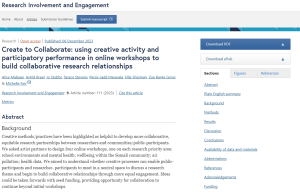Building collaborative research relationships through creative activities
7 December 2023
Engaging in creative activities can help to shift the power dynamics between public contributors and researchers, according to a paper published in BMC Research Involvement and Engagement. However, collaborative projects need to work for everyone and taking community-led ideas forwards remains challenging.
Create to Collaborate was a project aimed at developing creative workshops for members of the public, researchers, and community organisations, who were potentially interested in working together on health research projects. It aimed to understand how creative activities could help build relationships and connections between different people.
The team at NIHR ARC West, the Elizabeth Blackwell Institute, University of Bristol and Bath Spa University asked different artists to design and facilitate online workshops around the following subjects:
- school environments and mental health
- wellbeing within the Somali community
- air pollution
- health data
The study team wanted to evaluate whether creative activities facilitated by artists could:
- help to enable more equal relationships between public contributors and researchers
- reduce power differences at the beginning of the research process
Workshops began with introductory games and activities rather than the usual introductions of what people’s roles were. Activities included games, playful tasks that challenge norms and support connections, role reversals, poetry, and an illustrated booklet on the topic for people to work through.
Members of the public enjoyed these approaches, describing workshops as engaging, enjoyable, interesting, great fun, exciting, uplifting, enlightening, non-judgemental, equitable, welcoming and friendly.
However, researchers’ views were more mixed. Some found it helpful to be introduced to new ways of engaging with people. Others found the activities less helpful and were confused about their role during the session.
Disrupting usual practice and challenging norms wasn’t straightforward. The study team found that trying to change researcher-participant hierarchies meant everyone needed more clarity over how their roles should be set up within a collaborative relationship.
The study team also found that deconstructing power dynamics left participants without a sense of ownership when it came to taking ideas forward. This could make establishing longer-term collaborations more difficult.
Where they did occur, collaborations were supported by senior leadership, staff resources and a well-established public involvement group.
Dr Michelle Farr, corresponding author, said:
“Creative activities and an external facilitator can be valuable in moving away from workplace agendas and creating space to explore new ideas from communities. However, there can be tensions between cultivating a collaborative, creative process during workshops and subsequently developing a specific research project.
“Researchers are time-poor, and work put into developing community relationships is not typically rewarded within the career pathways of academia. Translating community-driven ideas into funded research projects faces capacity challenges, particularly relating to funding and researcher time. Co-production could be further supported by increasing researcher access to training, resources, networks and funds.”
Paper
